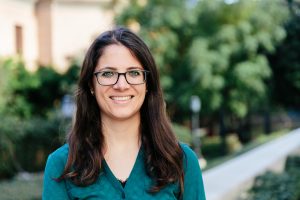by Consultant Tania Schleck
This article was originally published in the June 2021 California Public Parking Association newsletter.
Minimum parking requirements, universal in most American cities, mandate that developers provide a specific number of parking spaces for the public to access any new or intensifying land use or development and to mitigate parking spillover on to the street. Some cities allow developers to pay a fee in lieu of providing the number of spaces required by local zoning ordinances.
Parking in lieu fees can benefit developers, cities, and the public. Developers gain flexibility in meeting minimum parking requirements and can save money on building an expensive parking structure or surface lot. The space saved on a site that would otherwise have been allocated to parking could be used for more people-centric – and in some cases revenue generating – uses. Cities gain greater flexibility and control over the construction and management of public parking, and when parking spaces are shared among multiple land uses, fewer spaces are needed to serve a mixed-use district or site. By giving developers options other than physical parking spaces to satisfy minimum parking requirements, cities ensure that parking is provided in the most efficient way possible. In lieu fees can also facilitate the development of constrained sites, such as those near transit stops, that may otherwise not be developed due to the need to build the required parking.
While in lieu fees can be an important funding source for communities to build new parking supply, as we increasingly view the world through a wider mobility lens, in lieu fee revenue should be considered for capital and even operational programs beyond the construction of new parking spaces. In recent years, some cities have discovered that revenue from in lieu fees can also be allocated toward infrastructure improvements or operational programs that improve access for drivers, cyclists, transit riders and pedestrians. Examples of improvements that can be funded by in lieu revenue that promote greater access and a more walkable area include:
- Bicycle and scooter parking, a bike or scooter share program, or bicycle valet program.
- Pedestrian-related improvements, including lighting and street amenities, that increase safety.
- Transit related improvements, such as expanded service or new bus shelters.
- Creation of a “shared mobility hub” or a central location in neighborhoods and areas of high parking demand that provide a single access point to a range of transportation options and services.
- A transportation demand management (“TDM”) program for employees in a community or district to provide amenities that encourage people to walk, bike, ride transit, or carshare instead of drive.
- Wayfinding systems to help encourage the use of existing parking resources.
- A shared parking program, where cities lease lots from private owners and incorporate the spaces into the public parking supply.
Allowing for greater flexibility in the in lieu fee fund allocation is important for the following key reasons:
High cost of constructing new parking. Constructing new parking is often the costliest method of providing access to a downtown or commercial district. This is particularly true if land needs to be acquired to build parking. Even if in lieu fee rates are set high enough to fund new parking, the rate may exceed the amount a developer would be willing or able to pay. A developer may instead elect to build the required spaces on-site. Further, depending on the community and market conditions, development can occur in “drips and drabs.” A critical mass of development is often necessary to generate the funds necessary to build a new parking facility. Due to these reasons, it is often pragmatic for cities to use in lieu revenue to promote more cost-effective methods of access, such as biking, walking or transit. Communities should first examine existing underutilized parking supply before building new facilities. New parking should only be considered when the city has a reasonable assurance that it would be highly utilized for significant periods of time throughout the day.
Building more parking can encourage more driving and traffic. When an abundance of parking is available at a destination, people are often more likely to drive and park at that destination, even when they are within convenient walking or bicycling distance. Even people who would be willing to walk, bike, or ride transit, may see driving as a more attractive option, with the knowledge they will easily find a parking space. This is true particularly in a free-parking environment, which is representative of the vast majority of parking spaces in America.
Improving walkability can enhance the effectiveness of existing parking supply. After all, every parking trip begins and ends as a pedestrian trip. Improving an area’s walkability tends to extend the parking catchment of an area and the effectiveness of the parking supply. Parking is an ends to a means, although in our auto-centric culture parking has been a proxy for access. If in lieu funds can be applied to improve access more cost effectively than building parking, doing so is a worthy use of funds.
Uncertain future demand for parking due to emerging transportation trends. The nature of automobile transportation may look significantly different in the next 30 years considering the already increasing use of Ride Apps such as Uber and Lyft, as well as the possibility of self-driving and self-parking vehicles. The number of vehicles per household and demand for parking may decrease. With future uncertainty about parking demand, funding more flexible and less expensive improvements is likely more practical than a long-term investment such as a parking structure. Parking structures equipped for adaptive reuse can be built, however, they cost significantly more than a standard parking structure. Providing flexibility for developers to build fewer parking spaces now will reduce the amount of underutilized private parking spaces well into the future.
Encouraging alternative modes of transportation can benefit communities. Ultimately, the goal of providing more parking in commercial districts is to promote access to that district. There are other methods to provide access than building more parking spaces, including those that encourage people to walk, bike, or ride transit. Encouraging non-solo driving methods of transportation has multiple benefits including reducing traffic (thereby reducing pollution and Greenhouse Gas emissions), promoting equity by offering multiple modes of transportation, and developing healthy, walkable communities. Furthermore, promoting walkable communities can promote economic development due to increased foot traffic in commercial districts.
Cities have adopted ordinances to allow in lieu fee funds to be used for alternatives to constructing parking. The City of Santa Monica allows in lieu fee funds to be used to expand public parking supply by leasing parking spaces from private owners and coordinating valet parking operations with private owners. The funds can also be used for trip reduction strategies, such as wayfinding, signage, information systems, management, circulation, and access. The City of Healdsburg allows in lieu fee funds to be used for bicycle and pedestrian improvements throughout the City.
In lieu fees are typically one-time fees charged to developers on a per space basis, which helps cities generate funds up-front and fund larger capital and operational improvements. However, it can be beneficial for cities to charge on-going in lieu fees rather than one-time fees, recognizing the operational and flexible nature of access needs. On-going fees can help cities maintain a steady cash flow to adapt to the changing needs of the community and to new technology and mobility options.
Parking in lieu fees have historically been viewed primarily as a tool that could be used to help fund public parking structures. However, communities can benefit from reimagining how they use parking in-lieu fee revenue to provide more access for all users. How rigid the requirements are for the use of in lieu fees may vary based on a number of factors including, in some cases, state laws. Cities should consult with their legal counsel when developing their in lieu fee ordinances and determining how much to charge.
Tania Schleck is a parking and mobility consultant with Walker Consultants, based in the firm’s Los Angeles office. She works with public agencies, institutions, and private owners on policies and studies designed to serve the parking and mobility needs of multiple user groups. Prior to joining Walker, she was a city planner for Eden Prairie, Minnesota, a suburb of Minneapolis, where she supported long-range planning efforts, coordinated entitlements, and updated the municipal code.
is a parking and mobility consultant with Walker Consultants, based in the firm’s Los Angeles office. She works with public agencies, institutions, and private owners on policies and studies designed to serve the parking and mobility needs of multiple user groups. Prior to joining Walker, she was a city planner for Eden Prairie, Minnesota, a suburb of Minneapolis, where she supported long-range planning efforts, coordinated entitlements, and updated the municipal code.

